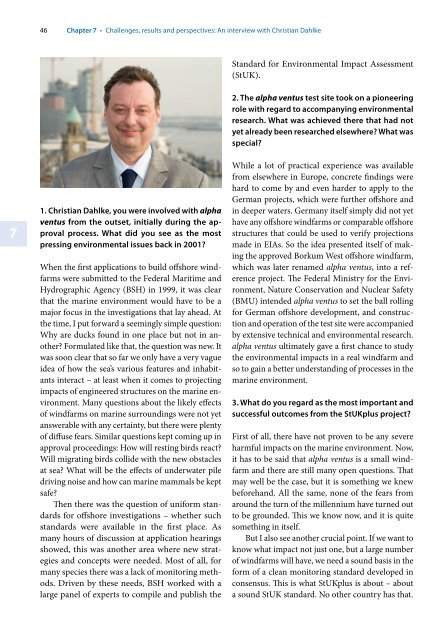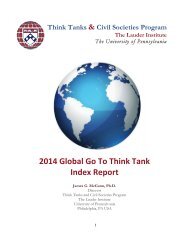bok%3A978-3-658-02462-8.pdf?auth66=1398409209_a0514c2b8e531c058ab8b810a0cad74d&ext=
bok%3A978-3-658-02462-8.pdf?auth66=1398409209_a0514c2b8e531c058ab8b810a0cad74d&ext=
bok%3A978-3-658-02462-8.pdf?auth66=1398409209_a0514c2b8e531c058ab8b810a0cad74d&ext=
- No tags were found...
You also want an ePaper? Increase the reach of your titles
YUMPU automatically turns print PDFs into web optimized ePapers that Google loves.
46Chapter 7 • Challenges, results and perspectives: An interview with Christian Dahlke12345678910111213141516171819201. Christian Dahlke, you were involved with alphaventus from the outset, initially during the approvalprocess. What did you see as the mostpressing environmental issues back in 2001?When the first applications to build offshore windfarmswere submitted to the Federal Maritime andHydrographic Agency (BSH) in 1999, it was clearthat the marine environment would have to be amajor focus in the investigations that lay ahead. Atthe time, I put forward a seemingly simple question:Why are ducks found in one place but not in another?Formulated like that, the question was new. Itwas soon clear that so far we only have a very vagueidea of how the sea’s various features and inhabitantsinteract – at least when it comes to projectingimpacts of engineered structures on the marine environment.Many questions about the likely effectsof windfarms on marine surroundings were not yetanswerable with any certainty, but there were plentyof diffuse fears. Similar questions kept coming up inapproval proceedings: How will resting birds react?Will migrating birds collide with the new obstaclesat sea? What will be the effects of underwater piledriving noise and how can marine mammals be keptsafe?Then there was the question of uniform standardsfor offshore investigations – whether suchstandards were available in the first place. Asmany hours of discussion at application hearingsshowed, this was another area where new strategiesand concepts were needed. Most of all, formany species there was a lack of monitoring methods.Driven by these needs, BSH worked with alarge panel of experts to compile and publish theStandard for Environmental Impact Assessment(StUK).2. The alpha ventus test site took on a pioneeringrole with regard to accompanying environmentalresearch. What was achieved there that had notyet already been researched elsewhere? What wasspecial?While a lot of practical experience was availablefrom elsewhere in Europe, concrete findings werehard to come by and even harder to apply to theGerman projects, which were further offshore andin deeper waters. Germany itself simply did not yethave any offshore windfarms or comparable offshorestructures that could be used to verify projectionsmade in EIAs. So the idea presented itself of makingthe approved Borkum West offshore windfarm,which was later renamed alpha ventus, into a referenceproject. The Federal Ministry for the Environment,Nature Conservation and Nuclear Safety(BMU) intended alpha ventus to set the ball rollingfor German offshore development, and constructionand operation of the test site were accompaniedby extensive technical and environmental research.alpha ventus ultimately gave a first chance to studythe environmental impacts in a real windfarm andso to gain a better understanding of processes in themarine environment.3. What do you regard as the most important andsuccessful outcomes from the StUKplus project?First of all, there have not proven to be any severeharmful impacts on the marine environment. Now,it has to be said that alpha ventus is a small windfarmand there are still many open questions. Thatmay well be the case, but it is something we knewbeforehand. All the same, none of the fears fromaround the turn of the millennium have turned outto be grounded. This we know now, and it is quitesomething in itself.But I also see another crucial point. If we want toknow what impact not just one, but a large numberof windfarms will have, we need a sound basis in theform of a clean monitoring standard developed inconsensus. This is what StUKplus is about – abouta sound StUK standard. No other country has that.




